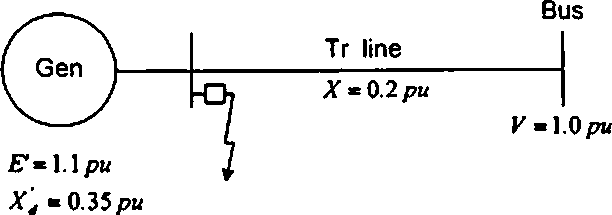Thapar University 2006 M.E Power System Dynamics & Stability - Question Paper
Thapar Institute of Engineering & Technology
M.E. Electrical & Instrumentation Engineering (1st Year)
Final Term exam
PS003(Power System Dynamics & Stability) Electrical & Instrumentation Engineering Department End Semester Examination : July-Dee 2006 PS003 Power System Dynamics & Stability
Time : Three Hour Max Marks 90
Note : Explanation should be brief & precise.
Attempt only six and only six questions.
Attempt ail parts of the question at one place.
1. (a) Explain why the SSR is not a problem in uncompensated and shunt compensated
transmission lines. 5
(b) Demonstrate that the transient stability of single machine infinite bus system can be explained through |pa d5 = 0. 5
(c) With the help of an electrical equivalent circuit of hydro turbine, explain the response for a step change in gate opening. 5
2. (a) Develop the classical transfer function of Hydro turbine and penstock system. 8
(b) Obtain the nonlinear model of the turbine while expressing the parameters on 100
MVA base for the following data -
Generator rating 160 MVA, Penstock length 300 m Rated hydraulic head 165 m,
turbine rating 125 MW
Piping area 11.15 m2
Water flow rate at rated load 85 m2/s
Gate opening at no load 0.06 pu
3. (a) Discuss the modified Euler method and the algorithm to calculate the multi machine stability using it. 9
(b) A 50 Hz generator is delivering 0.9 pu power to an infinite line through a transmission line as shown below. A three phase short circuit occurs at the generator end. Compute the swing curve for 0.1 sec assuming the time step size of 0.05 sec when fault is cleared by the opening of circuit breaker in 2.5 cycles. 6
|
Infinite |
 |
4. (a) Discuss the compensation schemes using SSSC and UPFC. Justify that UPFC is regarded as generalized SSSC. 10
(b) What is SVC arrangement and its characteristics. How it help in improving the stability. 5
5. (a) Discuss the SSR phenomenon and make a distinction between SSR due to Self excitation effect and interaction with torsional oscillations. 10
(b) Classify the small disturbances with the help of synchronous and damping torque. Also draw their characteristics 5
$. (a) Discuss the static excitation systems through neatly drawn schematic diagrams. 10
(b) What is load compensation scheme with reference to control arrangement for excitation system. 5
7. (a) Develop the block diagram of single machine infinite bus system using classical
generator model for small signal stability. 10
(b) Explain characteristic of simple radial system to understand the voltage stability. 5
8. (a) Using the d-q variable model of synchronous machine with rotor having field winding
and one q-axis winding, discuss the procedure to compute the steady state values. Also compute 5,>edteqi *** V'jsmV'i, T* for the generator parameters
given as -
Li = 0.15, Ra = 0.003, L/d = 0.165,
Rfd = 0.00006, Liq = 0.7252, Riq = 0.00619
Assume that the generator is delivering rated MVA at 0.8 (lag) pf at rated voltage and the effect of saturation is to reduce L and Lag to 85% of value given above. 10
(b) Using the d-q variables, show that the instantaneous power can be expressed in terms of power transfer across air gap, ohmic losses in armature resistance and rate of change of armature magnetic energy. 5
|
Attachment: |
| Earning: Approval pending. |
